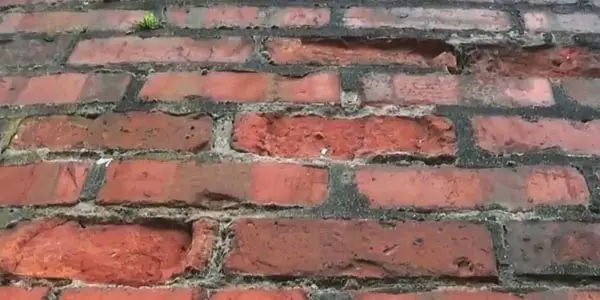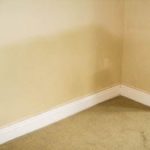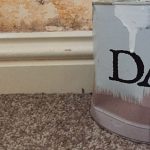The DIY Fix is reader supported. When you buy after clicking a link on our site, we may earn an affiliate commission.
When most people think of rising damp, the first thing that usually springs to mind is internal and cosmetic damage. This includes things like, wet tide marks on walls, flaking paintwork, wallpaper peeling away from the wall and rotten skirting boards.
Whilst these cosmetic issues are unsightly, frustrating and often costly, they are not compromising the structure of your property. The damage is purely cosmetic. If you resolve the rising damp issues and make repairs to your internal decor and woodwork, the problem is usually solved.
However, damage to decorating is not the only issue that can arise from rising damp. If left untreated, there is the potential to cause more serious structural damage over longer periods of time.

Rising damp can cause damage to building materials such as brickwork overtime.
Moisture travels through the bricks and mortar via capillary action. This introduces salts that can damage the mortar and masonry. This also increases the potential for spalling, which causes the bricks to crack and break during freeze thaw cycles.
How do bricks become damaged due to spalling?
Spalling is quite common and can be caused by a variety of issues including:
- Poor pointing
- Water penetrating through masonry defects
- Rising damp
- Etc.
Whatever the cause, the outcome is the same, water and salts build up in the masonry and exert pressure. Overtime, this will cause the surface of the brick to blow off, or cause cracks in the brickwork.
This can happen for a couple of different reasons. The first happens when water travels through the masonry carrying salts. As the brickwork dries, the salts are deposited in the pores inside the masonry and mortar. Over time this can build up filling the pores.
Salts are very absorbent, so this means that they continue to draw moisture, in turn this results in further growth of salt crystals. Eventually, pressure will build up and cause cracking and crumbling in the masonry.
The second way spalling occurs is via freeze thaw cycles. As water saturates the brickwork it fills the pores. This alone will exert a certain amount of additional pressure. However, this can be increase significantly in cold conditions.
At first when water becomes cooler, like most things it contracts, which means it takes up less space in the brickwork. This means that more water can fill the pores in your masonry.
However at 4 degrees Celsius, something strange happens. At this temperature the water begins to expand slightly. Once the water reaches 0 degrees it freezes, this results in an expansion of approximately 9%. You can read more about this here.
The result of this freezing and expansion is additional pressure on the masonry and mortar. This can cause pointing to blow out and break away. It can also result in the brick face blowing off. As well as cracking and crumbling.
Future problems with damaged bricks
Damage to bricks caused by water is quite common. Rising damp could continue to cause issues if left untreated. However, even if rising damp doesn’t cause serious damage to bricks, minor spalling issues could develop into bigger problems down the road.
Once a brick becomes damaged, it becomes vulnerable to other potential issues. The main one being penetrating damp.
For example, if the front of a brick has blown due to spalling, it will mean that the stronger outer surface of the brick is compromised. This will expose the more porous inner part of the brick to outside moisture.
This could result in further deterioration of the masonry, as well as the potential for more internal damage from penetrating damp.
Essentially, you could completely solve your rising damp issue and then still have issues with penetrating damp.
The key is to stop the rising damp before it damages bricks. Alternatively, if the damage is already done, you should replace the damaged bricks after your rising damp issues have been repaired.
Prevention is almost always easier than the cure. Most rising damp issues can be resolved DIY, with a damp proof injection cream. Alternatively, you could hire a professional to do this work for you.
A professional may be a better alternative, if you do have more serious damage to the masonry.
When hiring damp proofing professionals, we recommend using online comparison services, unless you already know somebody that specialises in damp.
The advantage with these services, is the contractors are all reviewed and rated. You can also see any relevant qualifications and previous customer feedback. Whats more, it tends to work out cheaper, because multiple companies are competing for the same work.
If you are interested in hiring a damp proof expert, we recommend a service called Bark. This service gets you up to 5 quotes from local damp companies. Click here to get free local quotes now.
Conclusion
As you can see, rising damp is one of many ways that bricks can become damaged overtime. Obviously, these are porous materials, this is usually a good thing, as it allows your property to breathe. However, if they are subjected to high levels of excess moisture this can cause problems.
In an ideal world, rising damp should be treated as soon as it is discovered. If this is the case, it is far less likely to cause damage to bricks. Even if there are defects in the brickwork following rising damp, it is often quite easy to fix. Usually, replacing damaged bricks and some re-pointing will solve the problem.
Problems would have to be left for a long time for any serious structural issue. With that said it is still a possibility in the long term. So again, try to prevent future issues. This can be done by solving the problems early, whilst they are less serious.




